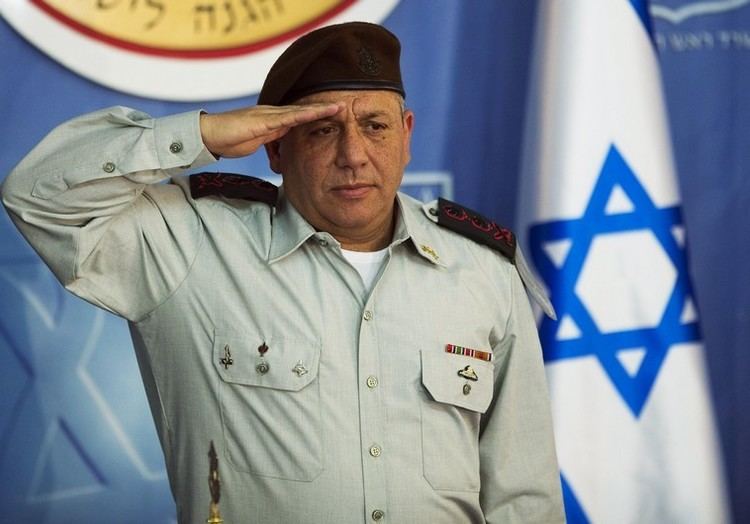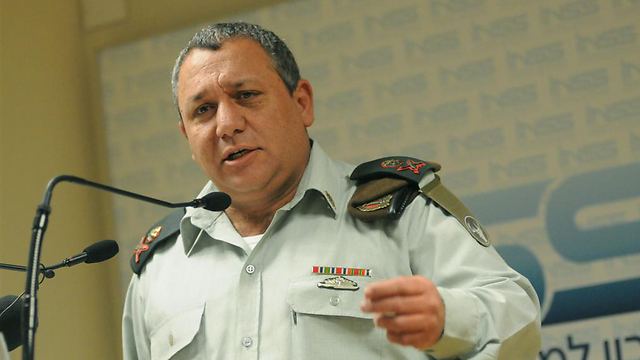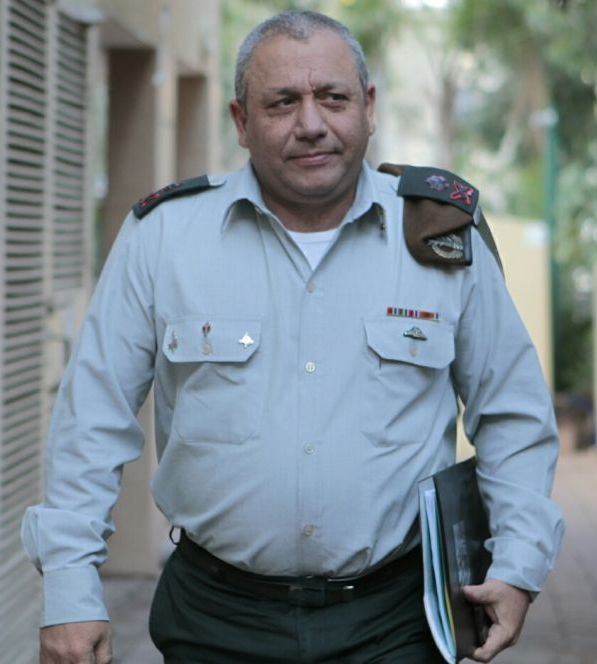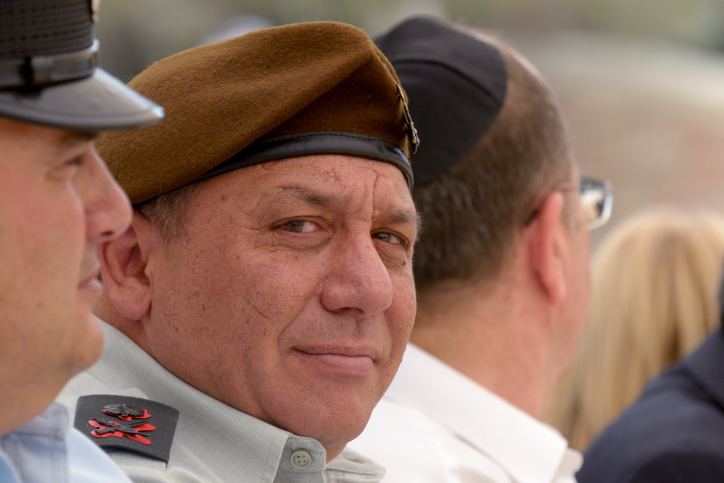Native name גדי איזנקוט Name Gadi Eizenkot Role Military Officer | Years of service 1978– Spouse Hanna Eizenkot (m. 1984) Rank Rav Aluf | |
 | ||
Commands held Commander of the Northern Command, Commander of the Golani Brigade, Military Secretary to the Prime Minister, Commander of the Judea and Samaria Division, Commander of the Operations Directorate Battles/wars 1982 Lebanon WarSouth Lebanon conflict (1982–2000)First IntifadaSecond Intifada2006 Lebanon WarOperation Cast LeadOperation Pillar of DefenseOperation Protective Edge Children Guy Eizenkot, Rotem Eizenkot Parents Esther Eizenkot, Meir Eizenkot Service/branch Operations Directorate, Northern Command | ||
Meet the new idf chief of staff lt gen gadi eizenkot
Gadi Eizenkot (Hebrew: גדי איזנקוט; born May 19, 1960) is the Chief of General Staff of the Israel Defense Forces, having taken the oath of office on February 16, 2015. He is the originator of the so-called Dahiya doctrine.
Contents
- Meet the new idf chief of staff lt gen gadi eizenkot
- New idf chief gadi eizenkot sworn in
- Biography
- Military career
- Chief of Staff of the IDF
- References

New idf chief gadi eizenkot sworn in
Biography

Gadi Eizenkot was born in Tiberias, in northern Israel. He is the second of four children to Ester and Meir, Jewish Moroccan immigrants from the town of Safi. His mother was born in Casablanca, and his father was born in Marrakesh.

Eizenkot grew up in the southern port city of Eilat, and studied at Goldwater High School, majoring in naval studies, but later chose to enlist to Golani infantry brigade.
He received a B.A. in history from Tel Aviv University and attended the United States Army War College for a master's degree.

Married to Hannah, an architect, with whom he has five children. Resides in Herzliya.
Military career
Eizenkot did his military service in the Golani Brigade, of which he became commander in 1997-98. He served as a soldier, a squad leader and a platoon Leader. In the First Lebanon War he served as a Company commander in Golani brigade. During the South Lebanon conflict (1985–2000) he served as the brigade's Operations Officer and as the commander of the Golani Orev Company. Later, he served as Golani's 13th Battalion commander, the Deputy to the Commander of the Brigade and an operations officer of the Northern Command. In 1997 he replaced Col. Erez Gerstein and was appointed commander of the Golani Brigade. During that time Eizenkot led the brigade in a series of operations in southern Lebanon that resulted 40 Hezbollah operatives killed.
In 1999 Eizenkot was selected to be the Military Secretary for the Prime Minister and the Minister of Defense under then Prime Minister Ehud Barak. Since then he has commanded the 366th Division and the Judea and Samaria Division, where he led the Campaign against Palestinian political violence. He was promoted to head of Israeli Operations Directorate in June 2005. After the conclusions exercise "joining of forces" Eizenkot led the formulation of the concept on which the IDF must severely damage the center of gravity of Hezbollah, the Dahiya neighborhood, as a key component for creating deterrence against Hezbollah. During the Second Lebanon War he was one of the few generals of the General Staff who dared to disagree with the Chief of Staff, Dan Halutz, and the measures proposed. Among other things he argued, at the beginning of the war, that the IDF must raise the reserve forces to improve preparedness for a large-scale ground offensive, and stressed that Israel must strive for a quick end of the war.
After Maj. Gen. Udi Adam resigned in October 2006 amid criticism over his conduct in the 2006 Lebanon War, Eizenkot replaced him as head of the Northern Command. In his years as the head of the Northern Command he emphasizes the training of forces, strengthening the capacities of command and creating an appropriate operational response to threats from Hezbollah and Syria.
On July 11, 2011, the position was transferred to Maj. Gen. Yair Golan, and Eizenkot went to study for a post-graduate degree at Haifa University in Political science. Afterwards he served as Deputy Chief of General Staff in place of Maj. Gen. Yair Naveh, assuming office on January 14, 2013. On November 28, 2014, Defense Minister Moshe Ya'alon and Prime Minister Benjamin Netanyahu chose Eizenkot as the successor to Gen. Benny Gantz as the Chief of Staff of the IDF.
Chief of Staff of the IDF
Eizenkot took office On February 16, 2015. Upon taking office he began to promote measures to strengthen the ground forces, including infantry training reinforcement and armor, reducing the volume of reserve forces on the one hand and reinforcing the amount of training on the other hand. In addition he emphasizes the training of forces regarding the threat of tunnels. Eizenkot Ordered the implementation of the multi-year plan "Gideon", that was formed under his direction. "Gideon" was presented in July 2015 and it was approved by the cabinet in April 2016. The plan involves a variety of issues which such as force buildup to a range of threats, strengthening and developing the IDF's maneuvering capabilities, eliminating redundant arrays and the constructing a cyber command. At the heart of multi-year plan stands "The IDF Strategy". This document was published in August 2015 defined three core elements: perception of use of force, concept of command and control and the principles of the force buildup derived from these perceptions. In the document Eizenkot determines the ultimate test of military action is the ability to sustain long periods of peace an safety in order to allow the state to develop. The long periods of peace an safety are the result of deterrence that achieved through military strength and the use of force. the strategy defines two types of campaigns:
An essential element relates to the purpose of ending the conflict in the shortest time. "The IDF Strategy" is trying to give this component a response by changing the pattern of the use of force by an immediate and simultaneous attack that combines maneuver and fire. "The IDF Strategy" also includes the strategic concept of campaigns between the wars (CBW), in which the IDF operate covertly in order to preserve and enhance the achievements of the previous campaigns, to weaken the enemy and to postpone the next conflict. In August 2016 Eizenkot was awarded with the Commander of the Legion of Merit by general Joseph Dunford. The award was given due to Eizenkot's "exceptionally meritorious service as chief of the General Staff of the IDF" and his "contribution to the strategic cooperation between the United States and Israel will have a lasting effect on both countries".
